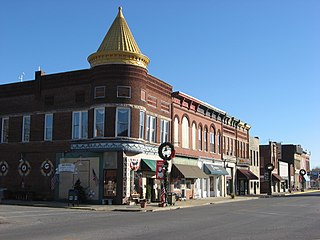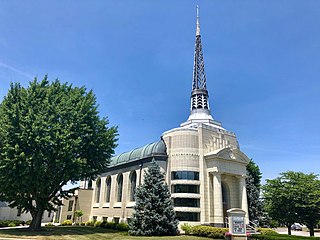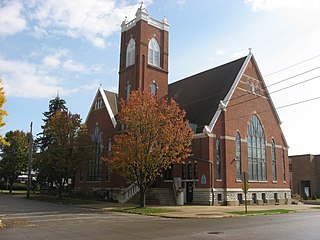
The Riverside Historic District is a U.S. historic district located in downtown Evansville, Indiana. It was added to the register in 1978 and roughly bounded by Southlane Drive, Walnut, Third, and Parrett Streets. It consists of 1,010 acres (4.1 km2) and 425 buildings. It is also known as the Riverside Neighborhood.

The Mount Zion Methodist Episcopal Church is a historic Methodist church located in Union Township, Delaware County, Indiana. It was built in 1867, and is a modest, one-room, brick church with a reconstructed bell tower. It measures 46 feet by 36 feet and sits on an uncut Indiana limestone foundation.

Vernon Historic District is a national historic district located in Vernon and Vernon Township, Jennings County, Indiana. It encompasses 42 contributing buildings and 3 contributing sites in Vernon. The district largely developed between about 1830 and 1900, and includes notable examples of Italianate, Greek Revival, and Federal style architecture. Notable contributing resources include the Jennings County Courthouse (1859), American House tavern, "Rat Row" apartments, Jacob Clinton House (1834), Judge Hickman New House (1832), John Bassnett House (1844), Gen. Robert S. Foster House (1840), Methodist Church (1817), Vernon Presbyterian Church (1832), Baptist Church (1871), a stone arch (1832), Tunnel Mill site, and Vinegar Mill site.

Allen Chapel African Methodist Episcopal Church is a church in Terre Haute, Indiana.

The First Presbyterian Church at 101 S. Lafayette in South Bend, Indiana is a former Presbyterian church building of First Presbyterian Church. It was built in 1888 and is a Richardsonian Romanesque style building constructed of fieldstonewith limestone trim. It has a cross-gable roof and features arched entrances, a massive Palladian window of stained glass, and a corner bell tower.

Aurora First United Methodist Church, also known as the First United Methodist Church of Aurora and Aurora Methodist Episcopal Church, is a historic Methodist church located at 304 Third Street in Aurora, Dearborn County, Indiana. It was built between about 1855 and 1862, and is a two-story, gable front, Greek Revival style brick building. It measures 45 feet, 6 inches, wide and 95 feet deep. A limestone front was added to the original building in 1903 and one-story rear addition built between 1885 and 1888. The church was remodeled in 1954.

Meridian–Forest Historic District is a national historic district located at Brazil, Clay County, Indiana. The district encompasses 220 contributing buildings and 13 contributing structures in a predominantly residential section of Brazil. The district developed between about 1866 and 1940, and includes notable examples of Italianate, Romanesque Revival, and Queen Anne style architecture. The district is characterized by brick streets and alleys. Notable buildings include the First Methodist Church, First Presbyterian Church, Masonic Lodge, Carnegie Library, and Brazil Junior High School.

Downtown Aurora Historic District is a national historic district located at Aurora, Dearborn County, Indiana. The district encompasses 272 contributing buildings, 1 contributing site, and 3 contributing structures in the central business district of Aurora. The district developed between about 1830 and 1944, and includes notable examples of Italianate, Federal, and Greek Revival style architecture. Located in the district are the separately listed Aurora City Hall, Aurora Methodist Episcopal Church, Aurora Public Library, First Evangelical United Church of Christ, First Presbyterian Church, George Street Bridge, Hillforest, Lewis Hurlbert, Sr. House, Leive, Parks and Stapp Opera House, and George Sutton Medical Office. Other notable buildings include the T. and J.W. Gaff Distillery (1843), First National Bank (1924), I.O.O.F. Hall (1887), B&O Railroad Station (1911-1917), John Neff Building, Chamber Stevens & Co. Dry Goods Store, U.S. Post Office (1935), Star Milling Co. (1891), and St. John's Evangelical Lutheran Church (1874).

Greenfield Courthouse Square Historic District is a national historic district located at Greenfield, Hancock County, Indiana. The district encompasses 72 contributing buildings and 1 contributing object in the central business district of Greenfield that developed between about 1835 and 1935. The focal point of the district is the Romanesque Revival style Hancock County Courthouse (1896-1897) and Second Empire style jail. Other notable buildings are the Riley School, A.J. Banks Building / Morgan Building (1869), Randall Block, Christian Church (1895), Bradley Methodist Church (1902), First Presbyterian Church (1906-1907), Carnegie Library (1908-1909), Andrew Jackson Banks House, D.H. Goble House, and Walpole House.

Independence Methodist Church is a historic Methodist church located at the junction of N500E and E375N southeast of Wheatfield in Gillam Township, Jasper County, Indiana. It was built in 1872, and is a one-story, simple rectangular frame building originally built in the Greek Revival style. It was later modified with Gothic Revival style lancet windows and Italianate style trim on the central belfry.

Plymouth Northside Historic District is a national historic district located at Plymouth, Marshall County, Indiana. The district encompasses 141 contributing buildings, 2 contributing sites, 6 contributing structures, and 3 contributing objects in a predominantly residential section of Plymouth. It developed between about 1870 and 1940, and includes examples of Italianate, Gothic Revival, Queen Anne, Colonial Revival, Tudor Revival, Neoclassical, and Renaissance Revival style architecture. Located in the district is the separately listed Marshall County Courthouse. Other notable contributing resources include Magnetic Park, First United Methodist Church (1914-1915), J.C. Capron House (1900), Samuel Schlosser House (1910-1911), Clay Metsker House (1917-1918), Plymouth Church of the Brethren (1950-1951), Logan-Stanley Fountain, Stevens House (1895), and First Presbyterian Church (1896-1897).

Orleans Historic District is a national historic district located at Orleans, Orange County, Indiana. The district encompasses 163 contributing buildings, 4 contributing sites, and 10 contributing objects in the central business district and surrounding residential sections of Orleans. It developed between about 1837 and 1958, and includes notable examples of Italianate, Queen Anne, Second Empire, Gothic Revival, Colonial Revival, Classical Revival, Tudor Revival, and Bungalow / American Craftsman style architecture. Notable buildings include the Cornelius-Osborn Building (1927), Magner-Lindsey Hotel, Roberts Building / Herle's Restaurant, Presbyterian Church, Methodist Episcopal Church (1915), Bowles Building (1889), Hollowell Brothers Building (1897-1898), Orleans Public Library (1915), and Ashland Service Station (1955).

Paoli Historic District is a national historic district located at Paoli, Orange County, Indiana. The district encompasses 144 contributing buildings, 1 contributing site, 4 contributing structures, and 4 contributing objects in the central business district and surrounding residential sections of Paoli. It developed between about 1840 and 1940, and includes notable examples of Greek Revival, Italianate, and Queen Anne style architecture. Located in the district are the separately listed Thomas Newby Braxtan House and Orange County Courthouse. Other notable contributing resources include Lithia Springs Park, Dr. J.H. Sherrod House (1885), Gabbert House, Lithia Water Bottling Plant (1920), Orange County Jail (1858), U.S. Post Office (1937), Presbyterian Church (1920), Methodist Episcopal Church (1888), Braxtan Store, Riley Building (1887), Paoli State Bank (1912), and Thomas Volney Thornton House (1846).

Rockville Historic District is a national historic district located at Rockville, Parke County, Indiana. The district encompasses 210 contributing buildings, 3 contributing structures, and 1 contributing object in the central business district and surrounding residential sections of Rockville. It developed between about 1826 and 1942, and includes notable examples of Italianate, Colonial Revival, and Queen Anne style architecture. Notable contributing resources include the Parke County Courthouse (1882), Memorial Presbyterian Church (1891), Sheriff' Residence and Jail, U.S. Post Office (1938), Rockville Public Library (1916), Methodist Episcopal Church, Rockville Grade School (1941), Parke County Seminary (1839), Rockville Opera House (1912), First National Bank (1907), Judge Samuel Maxwell House, Dr. P.Q. Stryker House (1838), Dr. Harrison J. Rice House (1880), and Dr. Marion Goss House (1907).

Brick Chapel United Methodist Church, also known as Montgomery Chapel, is a historic Methodist church located in Monroe Township, Putnam County, Indiana. The church was built in 1872, and extensively remodeled in 1912 in the Renaissance Revival style. A Sunday School addition was built in 1956. It features a large stained glass window, recessed arches, and an entrance tower. Also on the property is the contributing church cemetery established in 1839, with over 2,000 burials.

Winchester Residential Historic District is a national historic district located at Winchester, Randolph County, Indiana. The district encompasses 142 contributing buildings, 1 contributing site, and 1 contributing structure in a predominantly residential section of Winchester. The district developed between about 1837 and 1950 and includes notable examples of Greek Revival, Italianate, Romanesque Revival, Colonial Revival, Prairie School, and Classical Revival style architecture. Notable buildings include the First Presbyterian Church of Winchester (1903), Winchester Friends Church (1897), First United Methodist Church (1900), Main Street Christian Church (1912), First Church of the Nazarene (1929), Carey Goodrich House (1858), Kizer-Marsh House, and W.E. Miller House (1910).

Tyson United Methodist Church, also known as Versailles United Methodist Church, is a historic Methodist church located at Versailles, Ripley County, Indiana. It was built in 1937, and is a two-story, Art Deco style church building sheathed in white glazed brick and terra cotta. It features a stylized Corinthian order front portico, round arched entry with bronze doors, and curved bays and ribbon windows. The church is topped by a tall, open lattice work spire of cast aluminum.

St. Paul Methodist Episcopal Church, also known as St. Paul United Methodist Church, is a historic Methodist Episcopal church located at Rushville, Rush County, Indiana. It was built in 1887, and is a one-story, cruciform plan, Victorian Gothic style brick building with a steeply pitched gable roof. A basement was added in 1923. It features a square bell tower, Gothic arched windows, decorative stone bands, and terra cotta accents.

Rushville Commercial Historic District is a national historic district located at Rushville, Rush County, Indiana. The district encompasses 54 contributing buildings in the central business district of Rushville. The district developed between about 1847 and 1940 and includes notable examples of Greek Revival, Italianate, Romanesque Revival, Classical Revival, Collegiate Gothic, Commercial style, and Art Deco style architecture. Located in the district are the separately listed Durbin Hotel, Melodeon Hall, and Rush County Courthouse. Other notable buildings include the former Methodist Episcopal Church (1847-1850), Church of Christ / Boys' and Girls' Club (1850-1853), Beher-King Block (1883), Presbyterian Church (1892-1893), Rushville National Bank (1911), Phoenix Lodge (1913–1915), Rushville Public Library, and former Castle Theatre (1939).

Stidham United Methodist Church is a historic Methodist church located at Shadeland, Tippecanoe County, Indiana. It was built in 1912–1913, and is a 1 1/2-story, co-axial plan Gothic Revival style brick building topped by a steeply sloped gable roof. It features a crenellated bell tower with masonry buttresses and an American Craftsman style plain wood portico.
























